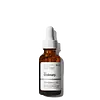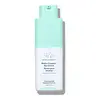What's inside
What's inside
 Key Ingredients
Key Ingredients

 Benefits
Benefits

 Concerns
Concerns

 Ingredients Side-by-side
Ingredients Side-by-side

Water
Skin ConditioningCaffeine
Skin ConditioningMaltodextrin
AbsorbentGlycerin
HumectantPropanediol
SolventEpigallocatechin Gallatyl Glucoside
AntioxidantGallyl Glucoside
AntioxidantHyaluronic Acid
HumectantOxidized Glutathione
EmollientMelanin
Skin ProtectingGlycine Soja Seed Extract
Skin ConditioningPentylene Glycol
Skin ConditioningHydroxyethylcellulose
Emulsion StabilisingPolyacrylate Crosspolymer-6
Emulsion StabilisingXanthan Gum
EmulsifyingLactic Acid
BufferingDehydroacetic Acid
PreservativeTrisodium Ethylenediamine Disuccinate
Propyl Gallate
AntioxidantDimethyl Isosorbide
SolventBenzyl Alcohol
Perfuming1,2-Hexanediol
Skin ConditioningEthylhexylglycerin
Skin ConditioningPhenoxyethanol
PreservativeCaprylyl Glycol
EmollientWater, Caffeine, Maltodextrin, Glycerin, Propanediol, Epigallocatechin Gallatyl Glucoside, Gallyl Glucoside, Hyaluronic Acid, Oxidized Glutathione, Melanin, Glycine Soja Seed Extract, Pentylene Glycol, Hydroxyethylcellulose, Polyacrylate Crosspolymer-6, Xanthan Gum, Lactic Acid, Dehydroacetic Acid, Trisodium Ethylenediamine Disuccinate, Propyl Gallate, Dimethyl Isosorbide, Benzyl Alcohol, 1,2-Hexanediol, Ethylhexylglycerin, Phenoxyethanol, Caprylyl Glycol
Water
Skin ConditioningOctyldodecanol
EmollientGlycerin
HumectantBoron Nitride
AbsorbentSaccharomyces/Xylinum/Black Tea Ferment
Skin ConditioningCoconut Alkanes
EmollientCetyl Alcohol
EmollientCetearyl Olivate
Sorbitan Olivate
EmulsifyingNiacinamide
SmoothingCopper Tripeptide-1
Skin ConditioningLeontopodium Alpinum Meristem Cell Culture
Skin ConditioningDipeptide-2
Skin ConditioningPalmitoyl Tripeptide-1
Skin ConditioningPalmitoyl Tetrapeptide-7
Skin ConditioningCopper Lysinate/Prolinate
Skin ConditioningHesperidin Methyl Chalcone
AntioxidantChondrus Crispus
MaskingMangifera Indica Seed Butter
Skin ConditioningGlycine Soja Oil
EmollientHippophae Rhamnoides Oil
EmollientSclerocarya Birrea Seed Oil
HumectantSodium Hyaluronate Crosspolymer
HumectantHydroxyethylcellulose
Emulsion StabilisingCoco-Caprylate/Caprate
EmollientSteareth-20
CleansingLecithin
EmollientPanthenol
Skin ConditioningN-Hydroxysuccinimide
Skin ConditioningUbiquinone
AntioxidantCitric Acid
BufferingThioctic Acid
AntioxidantTocopherol
AntioxidantChrysin
Skin ConditioningSclerotium Gum
Emulsion StabilisingMethylglucoside Phosphate
Skin ConditioningXanthan Gum
EmulsifyingPotassium Sorbate
PreservativeSodium Benzoate
MaskingChlorphenesin
AntimicrobialCaprylyl Glycol
EmollientSodium Hydroxide
BufferingPhenoxyethanol
PreservativePentylene Glycol
Skin ConditioningWater, Octyldodecanol, Glycerin, Boron Nitride, Saccharomyces/Xylinum/Black Tea Ferment, Coconut Alkanes, Cetyl Alcohol, Cetearyl Olivate, Sorbitan Olivate, Niacinamide, Copper Tripeptide-1, Leontopodium Alpinum Meristem Cell Culture, Dipeptide-2, Palmitoyl Tripeptide-1, Palmitoyl Tetrapeptide-7, Copper Lysinate/Prolinate, Hesperidin Methyl Chalcone, Chondrus Crispus, Mangifera Indica Seed Butter, Glycine Soja Oil, Hippophae Rhamnoides Oil, Sclerocarya Birrea Seed Oil, Sodium Hyaluronate Crosspolymer, Hydroxyethylcellulose, Coco-Caprylate/Caprate, Steareth-20, Lecithin, Panthenol, N-Hydroxysuccinimide, Ubiquinone, Citric Acid, Thioctic Acid, Tocopherol, Chrysin, Sclerotium Gum, Methylglucoside Phosphate, Xanthan Gum, Potassium Sorbate, Sodium Benzoate, Chlorphenesin, Caprylyl Glycol, Sodium Hydroxide, Phenoxyethanol, Pentylene Glycol
 Reviews
Reviews

Alternatives
Ingredients Explained
These ingredients are found in both products.
Ingredients higher up in an ingredient list are typically present in a larger amount.
Caprylyl Glycol is a humectant and emollient, meaning it attracts and preserves moisture.
It is a common ingredient in many products, especially those designed to hydrate skin. The primary benefits are retaining moisture, skin softening, and promoting a healthy skin barrier.
Though Caprylyl Glycol is an alcohol derived from fatty acids, it is not the kind that can dry out skin.
This ingredient is also used as a preservative to extend the life of products. It has slight antimicrobial properties.
Learn more about Caprylyl GlycolGlycerin is already naturally found in your skin. It helps moisturize and protect your skin.
A study from 2016 found glycerin to be more effective as a humectant than AHAs and hyaluronic acid.
As a humectant, it helps the skin stay hydrated by pulling moisture to your skin. The low molecular weight of glycerin allows it to pull moisture into the deeper layers of your skin.
Hydrated skin improves your skin barrier; Your skin barrier helps protect against irritants and bacteria.
Glycerin has also been found to have antimicrobial and antiviral properties. Due to these properties, glycerin is often used in wound and burn treatments.
In cosmetics, glycerin is usually derived from plants such as soybean or palm. However, it can also be sourced from animals, such as tallow or animal fat.
This ingredient is organic, colorless, odorless, and non-toxic.
Glycerin is the name for this ingredient in American English. British English uses Glycerol/Glycerine.
Learn more about GlycerinHydroxyethylcellulose is used to improve the texture of products. It is created from a chemical reaction involving ethylene oxide and alkali-cellulose. Cellulose is a sugar found in plant cell walls and help give plants structure.
This ingredient helps stabilize products by preventing ingredients from separating. It can also help thicken the texture of a product.
This ingredient can also be found in pill medicines to help our bodies digest other ingredients.
Learn more about HydroxyethylcellulosePentylene glycol is typically used within a product to thicken it. It also adds a smooth, soft, and moisturizing feel to the product. It is naturally found in plants such as sugar beets.
The hydrophilic trait of Pentylene Glycol makes it a humectant. As a humectant, Pentylene Glycol helps draw moisture from the air to your skin. This can help keep your skin hydrated.
This property also makes Pentylene Glycol a great texture enhancer. It can also help thicken or stabilize a product.
Pentylene Glycol also acts as a mild preservative and helps to keep a product microbe-free.
Some people may experience mild eye and skin irritation from Pentylene Glycol. We always recommend speaking with a professional about using this ingredient in your routine.
Pentylene Glycol has a low molecular weight and is part of the 1,2-glycol family.
Learn more about Pentylene GlycolPhenoxyethanol is a preservative that has germicide, antimicrobial, and aromatic properties. Studies show that phenoxyethanol can prevent microbial growth. By itself, it has a scent that is similar to that of a rose.
It's often used in formulations along with Caprylyl Glycol to preserve the shelf life of products.
Water. It's the most common cosmetic ingredient of all. You'll usually see it at the top of ingredient lists, meaning that it makes up the largest part of the product.
So why is it so popular? Water most often acts as a solvent - this means that it helps dissolve other ingredients into the formulation.
You'll also recognize water as that liquid we all need to stay alive. If you see this, drink a glass of water. Stay hydrated!
Learn more about WaterXanthan gum is used as a stabilizer and thickener within cosmetic products. It helps give products a sticky, thick feeling - preventing them from being too runny.
On the technical side of things, xanthan gum is a polysaccharide - a combination consisting of multiple sugar molecules bonded together.
Xanthan gum is a pretty common and great ingredient. It is a natural, non-toxic, non-irritating ingredient that is also commonly used in food products.
Learn more about Xanthan Gum